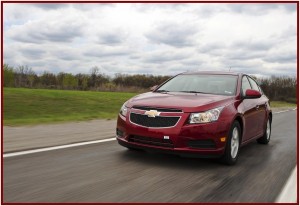
Built in the same Ohio plant as the late, unlamented Chevrolet Vega, Cruze is light years ahead of previous GM small cars.
A new study by Chevrolet shows that drivers in identical cars can differ in their fuel economy by as much as 16 mpg or 40%. This means that by practicing simple techniques a driver can save as much as $100 a month at the pump.
The results support data from OnStar that shows the fuel economy of drivers in identical cars can vary by 75%.
To demonstrate ten common mistakes drivers make that hurt their fuel economy, Chevrolet drove two identical compact cars on what it called a typical workday commute.
For the drive, GM fuel-economy engineers Ann Wenzlick and Beth Nunning drove identical Chevrolet Cruze LTs, which the EPA estimates get 24 mpg city, and 36 mpg highway. For the route, they drove both cars for 20 minutes, including city and highway driving, as well stopping for coffee.
Wenzlick averaged 37 miles per gallon using efficient driving habits in a properly maintained Cruze. Driving inefficiently and ignoring common maintenance, Nunning managed only 21 miles per gallon.
The difference means Nunning would get 250 fewer miles per tank of gas, while Wenzlick would save $100 a month, or $1,200 a year, assuming 15,000 miles and $4 a gallon for gasoline.
With a well-maintained car, the best drivers get up to 25% more miles per gallon than average.
“When you combine a poorly maintained car with inefficient driving habits, the fuel economy of the worst drivers can be 50% below average,” said Roger Clark, manager of the GM Energy Center.
| Wenzlick drive | 37 mpg | 575 mi per tank | $1,621per year |
| Nunning drive | 21 mpg | 325 mi per tank | $2,857 per year |
| Savings | 40% | 250 mi per tank | $1,236 per year |
Here are things Wenzlick did to drive more efficiently:
- Get out of the drive-through lane. While Nunning waited in the drive-thru with her car running, Wenzlick shut off the engine and went inside for coffee. Idling for 15 minutes burns through an average of a quarter of a gallon – adding another $1 to the cost.
- Take it easy. In the city, Wenzlick accelerated smoothly while Nunning demonstrated one of the most common mistakes – jumping on the gas at every light, only to hit the brakes as she caught up with the traffic ahead. Such aggressive driving isn’t going to get you home any faster, while driving smoothly can improve your mileage by 20%.
- Driving 70, not 80. On the highway, Wenzlick drove 70, compared to Nunning’s 80. A 10-mph difference likely won’t add much time to your daily commute, but it will save you up to four miles per gallon on the highway.
- Use cruise control. Wenzlick tried to maintain a constant speed during our drive, while Nunning’s fluctuated with traffic. Try using cruise control when possible, and maintaining a constant speed over time, which is much more efficient than speeding up and slowing down over and over again.
- Roll up the windows. At slower speeds, turning off the air conditioning can save you a little, but roll up the windows on the highway. Nunning was driving with her windows down, and the increased air pressure acted like a parachute trying to slow her down – consuming much more energy than air conditioning ever will.
Common Vehicle Mistakes That Hurt MPG:
Here are things that contributed to Nunning’s poor fuel economy:
- Low tire pressure. All four tires on the car were five pounds under their recommended air pressure. That’s not enough to change how the Cruze drives, but it does make the engine work much harder to turn the wheels. Check your tires at least once a month, as a tire that is 10 pounds under pressure can cut your fuel efficiency by more than 3%.
- Using roof ornaments. Nunning put up window flags supporting the Detroit Tigers baseball club. At highway speeds, up to a third of your fuel is used to overcome wind resistance, so even small changes to your vehicle’s aerodynamics will have a big impact in fuel economy.
- Carrying extra junk in the trunk. There were six bags of water-softener salt in the trunk. According to EPA estimates, every 100 pounds of weight can reduce fuel economy by 2% percent. The 240 pounds of salt added almost 5% to fuel costs for the trip.
- Ignoring the “check engine” light. OnStar ran a remote diagnostics check because the check engine light was on. The light was on because the gas cap was loose. More serious engine problems can cut your fuel economy by up to 40%.
- Not bundling errands. An engine at operating temperature is up to 50% more efficient than a cold engine. So, when possible, it’s much better to run five errands in an afternoon, than running one errand every day of the week.
(See also Driving Impression – Chevrolet Cruze)

